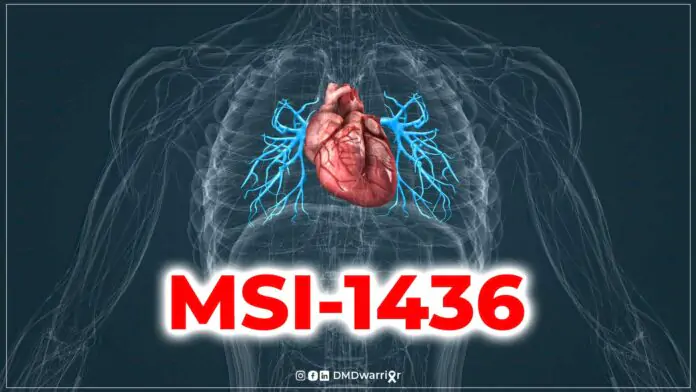Human babies may indeed repair myocardial damage and fully recover normal cardiac function following a severe myocardial infarction, despite the seemingly unrealistic idea that the human body can regenerate damaged heart muscle. Revidia Therapeutics’s lead drug candidate is MSI-1436, the first small molecule shown to activate regeneration in the adult mammalian heart.
Table of Contents
The risk of heart failure in patients diagnosed with DMD
Mutations in the dystrophin gene, the biggest and most intricate gene in the human genome, result in Duchenne muscular dystrophy (DMD), an X-linked orphan disease. A big structural protein called dystrophin shields muscle cells from harm brought on by contraction. Current technology cannot entirely fix dystrophin mutations that cause DMD or introduce a full-length dystrophin transgene into human cells due to the size and complexity of the dystrophin gene. Currently, DMD is incurable.
DMD is a cardiac illness, even though it is typically thought of as a skeletal muscle disease with severe, progressive muscle degradation. In their mid- to late-20s, the majority of DMD patients pass away from heart failure.
Patients with DMD commonly lose the ability to walk by their early teens, with symptoms usually starting between the ages of 3 and 5. Cardiac muscle degeneration brought on by a loss of dystrophin activity in the heart eventually results in dilated cardiomyopathy and heart failure. The heart’s capacity to pump blood is weakened by dilated cardiomyopathy, which causes the ventricles to swell and their walls to thin. Cardiomyopathy is present in the majority of DMD patients by their late teens and can be identified in kids as early as 10.
Although DMD cardiomyopathy contributes to mortality, there are currently no approved treatments for it, and efforts to develop cardiac medicines have been minimal. Steroids and other conventional heart failure medications are used in current DMD cardiac therapy to decrease the damage that inflammation, stress, and remodeling cause to the heart.
Exon skipping and gene therapies for DMD
To treat DMD, a lot of resources and attention have gone into developing genetic therapies. Gene transfer therapy and exon-skipping are examples of approved genetic techniques in the US. Antisense oligonucleotides (AONs) intended to “skip” mutant regions of the dystrophin gene are used in exon-skipping therapies. In tiny fractions of DMD patients, AONs target particular dystrophin mutation types. Gene transfer treatments introduce a partial or “micro-dystrophin” transgene into skeletal muscle cells using viral vectors. – Read More: What is Exon Skipping? –
DMD cannot be cured by exon-skipping or microdystrophin gene transfer treatments. Both strategies aim to increase expression of partially functioning, shortened dystrophin proteins, hence reducing symptoms associated with skeletal muscle. Neither strategy has demonstrated reliable, consistent clinical efficacy, even though it was given rapid FDA permission for use in the US. There are serious safety issues with micro-dystrophin gene transfer treatments as well. Recent leadership changes at the FDA have raised questions about the agency’s expedited approval procedure for genetic medicines like these.
The fact that genetic and other skeletal muscle targeted therapies do not address dilated cardiomyopathy and the resulting heart failure, which is the main cause of mortality for DMD patients, is another significant disadvantage. Moreover, cardiac morbidity and mortality may be increased by any treatment that markedly enhances skeletal muscle activity without also increasing heart function. More blood flow is necessary for improved skeletal muscle performance, which increases the workload of an already compromised heart. Therefore, a single therapy agent or a combination of therapies that address both skeletal and cardiac muscle dysfunction will be necessary for the most successful treatment of DMD.
No stem cell regenerative medicine therapy has received FDA approval
Regenerative medicine has long been the cornerstone of cardiology’s hopes for treating heart injury. In order to mediate heart repair and regeneration, the majority of regenerative medicine businesses have concentrated on developing stem/progenitor cell transplantation and infusion techniques. The fact that transplanted or infused stem cells do not engraft with cardiac tissue is now widely known. The “paracrine hypothesis” postulates that these cells’ capacity to release substances that promote intrinsic repair and regenerative processes is what causes the sporadic, tiny, and wildly inconsistent therapeutic effects. It is unclear what these factors are and what signaling pathways they activate.
No stem cell regenerative medicine treatment has been approved by the FDA in spite of more than 20 years of rigorous research and development. Stem cell therapies continue to face difficulties due to their high cost, major manufacturing issues, limited efficacy, and complexity. One example is deramiocel, which is being developed to address damage to the heart and skeleton in people with DMD.
Using cultivated cardiac progenitor cells, Deramiocel is an experimental allogenic cell treatment that is infused once every three months. Small vesicles containing paracrine substances with immunomodulatory and other tissue-pro-repair capabilities are released by the injected cells. Deramiocel’s marketing application was recently denied by the FDA, which stated that the experimental treatment “does not meet the statutory requirement for substantial evidence of effectiveness.” The FDA also expressed concerns about CMC (chemistry, manufacturing, and controls). Read More: What is Deramiocel? –
Mission of Revidia Therapeutics
The goal of Revidia Therapeutics is to create first-of-a-kind small molecule medications that stimulate natural heart regeneration and repair.
Regarding cardiac regenerative medicine, Revidia Therapeutics has adopted a distinct strategy. The company was established on the tenet that the human heart and other organs have strong natural healing and repair mechanisms that are deactivated soon after birth. After a severe myocardial infarction, human neonates may actually repair myocardial damage and fully recover normal cardiac function, but the idea that the human body can regenerate damaged heart muscle may seem unrealistic. As a newborn grows older, this ability is lost. Many animals maintain the capacity to regenerate complex tissues and organs throughout their lives, and other newborn mammals possess the same capacity.
What is MSI-1436?
MSI-1436, the first small molecule demonstrated to stimulate regeneration in the adult mammalian heart, is the company’s top therapeutic candidate. Revidia Therapeutics has now shown in three animal species and numerous damage models, including six different forms of cardiac injury, how well MSI-1436 stimulates the repair and regeneration of heart muscle and other tissues.
Competitive Benefits Of Drugs With Small Molecules
The pharmaceutical business and medicine rely heavily on small molecules. Small molecules provide the following competitive advantages over other cardiac regenerative medicine treatments now under development: 1) relative cost-effectiveness, 2) ease of delivery, and 3) ready reversibility in the event of an unfavorable reaction.
One significant benefit of MSI-1436 is that its human safety profile is already well-established. Phase 1/1b clinical studies of MSI-1436 as a possible therapy for type 2 diabetes and obesity were conducted by Genaera Corporation in 2008. According to these clinical trials, MSI-1436 has a high estimated therapeutic index for the treatment of heart ailments. The highest well-tolerated dose set by Genaera is five to fifty times higher than the doses of MSI-1436 that promote tissue regeneration and enhance heart function in animal models.
What Does Revidia Therapeutics Say?
Numerous factors have influenced ongoing research and development programs and clinical development plans, including the debilitating nature of DMD, the unmet medical need of the primary cause of death in DMD patients, extensive efficacy testing, the many benefits of small molecule drugs over stem cell-based therapies, the ongoing difficulties of genetic DMD therapies, and—most importantly—the proven human safety of MSI-1436. For the treatment of dystrophinopathies—inherited muscle disorders brought on by abnormalities in the dystrophin gene—Revidia Therapeutics has been designated as an FDA Orphan Drug. ODD will grant MSI-1436 seven years of market exclusivity if it is authorized for use in patients with DMD.
MSI-1436 is now in the latter stages of preclinical development, and an IND application is anticipated to be submitted in 2026. MSI-1436 is expected to improve patients’ quality of life, prolong their lifespans, and lessen the psycho-social effects of DMD cardiomyopathy on patients and their caregivers if it proves effective in treating the condition and is authorized for use by patients. Beyond DMD cardiomyopathy, we also hope that MSI-1436 will have numerous potential regenerative medicine uses in tissues other than the heart.



